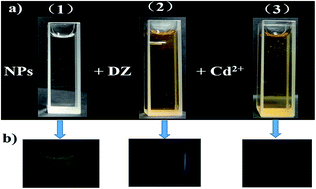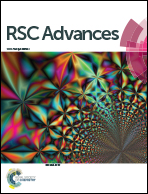Dithizone-etched CdTe nanoparticles-based fluorescence sensor for the off–on detection of cadmium ion in aqueous media
Abstract
In the present study, a new fluorescence probe based on dithizone-etched CdTe nanoparticles was designed for the sensitive and selective detection of cadmium ions in environmental samples via a reversible off–on fluorescence mode. At first, the initial bright fluorescence of L-cysteine-capped CdTe NPs could be effectively quenched in the presence of dithizone (DZ) due to the chemical etching effect, which results from the breaking of Cd–thiol layers by DZ, thus leading to a decrease in the NPs surface passivation. Then, upon the addition of Cd2+, the weak fluorescence of the CdTe NPs–DZ system gradually recovered, owing to the occurrence of Cd–thiol passivation layers on the surface of the NPs. Under optimal conditions, a good linear relationship was obtained in the range from 0.4 μM to 15.4 μM for Cd2+, with a detection limit of 0.13 μM. In addition, this CdTe NPs-based nanosensor presents remarkable selectivity for Cd2+ over other metal ions and was successfully applied for the detection of Cd2+ in real water samples with satisfactory results, demonstrating its potential application for the determination of Cd2+ in the environment.



 Please wait while we load your content...
Please wait while we load your content...